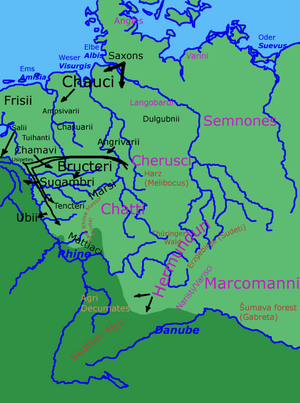Varini
| Author:Laxman Burdak, IFS (R) |

Varini (वरिणी) were one or more Germanic peoples who originally lived in what is now northeastern Germany, near the Baltic Sea.
Variants
- Warni
- Warini
- Werns
- Warns
- Varinnae (by Pliny the Elder)
- Viruni (Ptolemy)
- Varioi (Οὐάρνων)
- Varinians/Varinian
- Varinae
- Ouarinoi (Ουαρίνοι)
Jat clans
Name and etymology
Tacitus spelled the name as Varini, Pliny the Elder as Varinnae, Ptolemy as Viruni (Ούίρουνοι), Procopius as Varioi (Οὐάρνων). Later attestations include Wærne or Werne in the Old English Widsith, and Warnii in the Lex Thuringorum.
The name supposedly meant either "defenders" or "living by the river" (from the Indo-European root *uer- "water, rain, river").[1]
History
They are first named in the Roman era, and appear to have survived into the Middle Ages. It is proposed that in Old English they were called Werns or Warns.
The earliest mention of this tribe appears in Pliny the Elder's Natural History (published about 77 AD). He wrote that there were five Germanic races, and one of these were the Vandals. These included the Burgodiones, the Varinnae, the Charini (not known from any other record) and the Gutones (Goths).[2]
Tacitus (about AD 56 – 120) gave the most information about the Varini in his Germania. He mentioned them as one of a group of remote Suevian peoples, living beyond (north and/or east of) the Semnones and Langobardi (who lived near the Elbe). He did not mention that they were Vandili.
External links
References
- ↑ Tarasov I.M. The Balts in the Migration Period. Veleti. // Аллея Науки, № 10 (26), Ноябрь, 2018. P. 263.
- ↑ Pliny, Natural History, 4.28 aka 4.40. Latin: Germanorum genera quinque: Vandili, quorum pars Burgodiones, Varinnae, Charini, Gutones.

